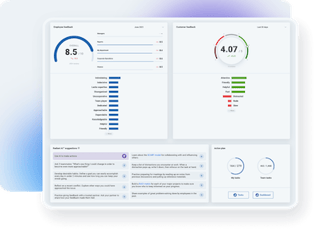
Implementing a Generative AI Tool: Building Your Business Rollout Plan
As part of our ongoing series exploring innovative technologies reshaping the modern workplace, this blog post focuses on the practical implementation of Generative AI. Building on previous discussions, we dive into the key phases of rolling out Generative AI across business operations, from preparation to performance metrics. The goal in implementing Generative AI technology is to quickly provide a high ROI to your business in a manner that seamlessly integrates into your current operations. As tools become more sophisticated and have the latest AI technology integrated, it will be more common to be rolling out Generative AI in multiple areas of business at once. Let’s start with a quick primer.
TABLE OF CONTENTS
loading...
What is Generative AI?
Generative AI refers to artificial intelligence focused on creating novel content, ideas, or data. Large language models (LLMs) trained on massive text and code datasets power it. Common uses of Generative AI include:
- Generating text like articles, posts, or marketing copy
- Creating images such as product photos or artwork
- Writing code including apps, scripts, or web pages
The value of Generative AI for businesses
With capabilities to automate content creation, optimize designs, summarize large amounts of text, personalize marketing, write well-formatted first drafts of business documents, and enhance data analysis, Generative AI unlocks innovation and efficiency. Its ability to quickly produce unique insights and content enables agile responses to evolving trends and demands. By reducing costs, accelerating processes, and revealing new opportunities, Generative AI is becoming integral to modern business strategy.
The Promising Future of Generative AI
Myriad applications across industries
The possibilities for Generative AI span nearly every industry. In marketing, it can generate thousands of personalized ads a minute. For healthcare, it can simulate patient scenarios for training purposes. Generative design can accelerate product innovation. Finance can benefit from predictive analytics. At Macorva, Generative AI is used to automatically create detailed reports that summarize customer feedback on a daily basis - a process that would be far too time-consuming to manually perform. The range of potential use cases is vast, each focused on meeting specific business goals.
Weighing the benefits and challenges
The benefits of Generative AI are numerous, including increased efficiency, cost reduction, enhanced creativity, and the ability to uncover hidden insights. It allows businesses to automate processes that were previously time-consuming and to innovate in ways that were previously unimaginable.
However, these advantages come with challenges. Implementing Generative AI requires specialized skills, ample computing power (or high costs for external systems), and an understanding of potential biases. Managing security, regulatory compliance, and ethical implications are key in leveraging its advantages while minimizing risks. To make sure your project has a successful implementation, there are some crucial things to keep in mind when building your rollout plan.
Preparing for Generative AI Implementation
Define your business goals
First, clearly define the specific goals you hope to achieve with Generative AI. Understanding how it will enhance creativity, automate processes, or otherwise benefit your business is crucial for tailoring the implementation to your needs. It’s helpful to start to assign dollar values to a best-case rollout scenario, as it helps everyone be focused on operational improvements and future reporting.
Identify your target audience
Knowing the audience that will interact with and benefit from the Generative AI application is vital. This includes both internal users (like employees or departments within your organization) and external users (like customers or partners). Identifying the target audience ensures that the implementation aligns with their needs and expectations. Keep in mind that these users are both the people initially using tools to create content, and sometimes a separate group that digests this newly created content. Criteria for excellent performance can be very different in each of these groups.
Map out use cases
Outlining the exact scenarios where Generative AI will be applied is essential. These use cases can vary widely across industries and functions, such as marketing, finance, or product development. Specifying the use cases helps in choosing the right tools and methodologies for successful implementation. You also need to think through where AI shouldn’t be used - for example, in high-stakes scenarios where a random factual or logic error could cause a big headache. While AI should be used for first drafts, it’s important to understand the implications of AI’s work not always being fully checked, and to adjust procedures to mitigate this impact.
Selection of the right Generative AI tool
The choice of the Generative AI tool should align with your defined goals, audience, and use cases. Consider factors like ease of use, scalability, cost, community support, and the level of customization offered / required. Reviewing the tool’s capabilities in real-world scenarios or seeking expert opinions can assist in making an informed decision.
Security and compliance considerations
Implementing Generative AI should not compromise the security and compliance standards of your organization. Assess the data privacy requirements, intellectual property concerns, and any industry-specific regulations that must be adhered to. Collaborate with legal and compliance teams to ensure that the implementation is within the bounds of applicable laws and standards. It’s important to understand there is a vast security difference between ChatGPT, Bard, and other tools designed for casual use, and business tools that use secure API connections to LLMs. Casual tools should be avoided in many business cases, but well-implemented API tools can be the path to securely increasing productivity.
Designing the Rollout Plan
The rollout plan for implementing Generative AI in the workplace requires careful planning across multiple phases. From initial testing to scaling up and finally, full deployment, each stage demands forethought, flawless execution, and follow-up. Below are the key considerations for each phase:
Phase 1: Pilot Testing
- Collect relevant data. Generative AI depends on sizable, high-quality data. Assess the data quality, source, and relevancy. Consider collaborating with data experts to ensure that all necessary data is ready and structured for optimal results. Use as much of your data as possible in testing.
- Set up the technology. Collaborate with the vendor to configure the initial settings and tailor the technology to match specific needs. Explore additional data or customization that could enhance the output quality.
- Train your team. Develop comprehensive documentation and guides for using the tool. Schedule training sessions, workshops, and demos for all affected teams. Appoint “AI advocates” or champions to foster ongoing learning and disseminate best practices across the organization. Keep in mind that many AI tools require little to no training or effort - and these can often be the best. They are simply fed the correct data and are able to create the appropriate reports.
- Monitor and adjust output. Regularly review the AI-generated content, comparing it against predefined standards. Work with both technical and business teams to adjust parameters, ensuring alignment with organizational objectives. Make sure you test best case and worst case scenarios. Don’t just focus on common uses, but make sure you think through all the edge cases that might appear. If you’re getting bad results in some of these, change procedures to selectively disallow AI use.
- Provide support. Recognize that Generative AI tools might present a steep learning curve, or at minimum have a different workflow than what many team members are used to. Set up a support system comprising hotlines, forums, or dedicated support staff to guide team members through the learning process. It’s also good to communicate the goals with employees so they feel well-informed about the business rationale and desired outcomes. This helps them feel like part of the team as operations are being changed.
Phase 2: Scaling Up
- Integration with Existing Systems. The integration process should be thorough, spanning various tech stacks and workflows. Collaboration between IT, business, and vendor teams will ensure a smooth integration process. The goal is to fully automate data transfer of everything that you have been testing - both input and output.
- Training and Support. As you scale, additional training and support mechanisms may be necessary. Regular refresher courses, advanced training for power users, and responsive support channels will contribute to success. Of course, the best Generative AI tools will need little training, as the driving point is to increase quality and productivity simultaneously.
- Iterative Improvement of Models. Continual refinement is vital. Regularly update parameters based on user feedback, performance analysis, and evolving business needs. Collaborate with data scientists for ongoing model optimization. Don’t assume that output is consistent - it’s up to you to monitor future performance. Generative AI models are inherently rapidly evolving. While vendors should be monitoring and adjusting on their side, it's wise to be prudent and understand that the nature of this AI technology is producing variable content that may change over time.
Phase 3: Full Deployment
- Maintenance and Ongoing Support. Full deployment requires a robust maintenance plan. Implement regular check-ups, updates, and a streamlined process for handling issues. Consider annual reviews with vendors for technology enhancements.
- Performance Tracking. Implement sophisticated tracking tools to monitor performance against KPIs. Regular reporting to stakeholders will ensure alignment with business goals and prompt action where necessary.
Additional Considerations
- Communication and Change Management. Clear communication and a structured change management plan will smooth the transition. Give regular updates, maintain transparency with stakeholders, and address concerns proactively.
- Risk Assessment and Mitigation. Pinpoint risks at each phase, and make plans to address them. Hold regular risk meetings and maintain a risk registry for proactive management.
- Create Continuous Feedback. Create channels for ongoing user and stakeholder feedback. This feedback loop will enable timely adjustments to ensure alignment with user needs and business goals.
Rollout Summary
The rollout plan design is strategic and requires alignment with the organization’s overall strategy and goals. Successfully implementing Generative AI in the workplace depends on a well-planned, executed, and managed rollout. By following this comprehensive, structured approach, organizations can harness the transformative potential of Generative AI in a controlled, effective way - adding value, enhancing innovation, and achieving competitive advantages. At the end, you should be able to present a workflow that is more efficient, produces better results, and possibly uses less resources. You should be able to show excellent ROI in operational efficiency and possibly increased customer satisfaction.
Metrics and KPIs
Defining success metrics
It’s vital to establish clear and measurable success metrics when deploying Generative AI in the workplace. These can include accuracy rates, efficiency improvements, cost savings, and user satisfaction levels. Aligning these metrics with business goals ensures that the implemented AI system is directly contributing to the organizational objectives. Remember, Generative AI projects should have high, clearly demonstrable ROIs. Put yourself in the driver’s seat to show off your success. And then get ready for the next AI project - as chances are there are many more opportunities in your organization.
Regular monitoring and reporting
Continuously monitoring established metrics is critical for understanding the AI system’s performance. Regular reporting helps spot trends, areas for improvement, and keeps stakeholders informed on progress. If possible, tools like real-time dashboards provide comprehensive performance views. While the initial KPI report may have the biggest splash, quarterly or annual updates are crucial to keep everyone focused on continuous improvement.
Adjustments and continuous improvement
The dynamic nature of business and this innovative technology requires the Generative AI system to adapt and evolve. Regular monitoring may reveal areas needing adjustment - model tuning, expanding datasets, or redefining metrics. A mindset of continuous improvement encourages innovation and alignment as the business landscape changes.
Conclusion
Implementing Generative AI at work is complex yet rewarding. It involves understanding the landscape, preparing for implementation, designing a robust rollout plan, and tracking performance through well-defined metrics. The journey demands collaboration, continuous learning, adaptation, and commitment to achieving business goals.
Final Thoughts
While embracing Generative AI holds great promise, understanding and conveying its tangible impact is critical for continued buy-in and funding. Measuring and communicating return on investment will be instrumental in making the case for ongoing Generative AI adoption.
In the next post, we will explore best practices for quantifying and presenting the ROI of implemented Generative AI systems, where we will provide actionable guidance on maximizing and conveying the substantial ROI of Generative AI investments.
Missed my previous blogs covering Generative AI in the workplace? Click the links below to read more:
- Part 1: The Generative AI Advantage: How to Responsibly Amplify Workplace Productivity
- Part 2: A Comprehensive Guide to Implementing Generative AI Tools
Editors note: this blog was originally published in August 2023 and has been updated for accuracy and comprehensiveness.
RELATED ARTICLES
Should You Use AI in Employee Performance Reviews? Pros, Cons & Best Practices
Consistent feedback is key to keeping employee engagement high. In fact, 79% of employees who quit cite a lack of recognition ...
Start Reading
How to Build Trust and Transparency in AI Performance Reviews
TL;DR: AI-powered performance reviews promise greater fairness and efficiency, but 70% of organizations still struggle to earn ...
Start Reading
Contact Center QA Evolution: From Sample Monitoring to AI Call Scoring & Performance Intelligence
Modern contact center leaders know the value of accurate performance intelligence. They also know the performance risks ...
Start Reading




